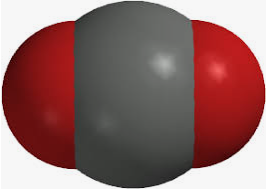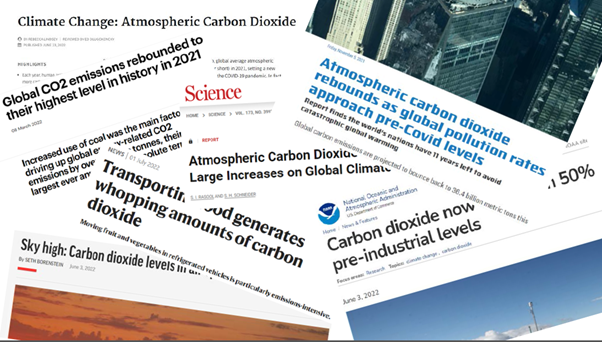Module 2704
Does carbon dioxide affect Earth’s energy balance?
What is the effect of carbon dioxide in our atmosphere?
What would be our average temperature if there were no carbon dioxide?
Is carbon dioxide good stuff or bad?
In this module, we focus on the effect on the temperature of the surface of Earth due to the presence of carbon dioxide in our atmosphere, and the magnitude of the effect.
Please accept for now a simplistic overview of what happens, and postpone questions related to the science of how carbon dioxide exerts an effect (Module 2705 The "greenhouse effect"), and why it does its thing (Module 2706 Why do carbon dioxide molecules absorb radiations emitted from Earth?).
Please accept for now a simplistic overview of what happens, and postpone questions related to the science of how carbon dioxide exerts an effect (Module 2705 The "greenhouse effect"), and why it does its thing (Module 2706 Why do carbon dioxide molecules absorb radiations emitted from Earth?).
Here is what happens (Level 1 of understanding)
Carbon dioxide molecules "capture" some of the radiation emitted from Earth's surface, and which would otherwise go off on a long journey into deep space.
Imagine the Earth in a state of energy balance (See Module 2701 Is Earth in energy balance?), the temperature remaining constant. The rate of outgoing radiation energy is equal to the rate of incoming radiation energy.
And then we inject some carbon dioxide into the atmosphere. Then not as much outgoing radiation (heat energy) escapes from Earth, and so the rate of incoming radiation energy is greater than the rate of emitted radiation energy. Temperature will increase until a new condition of energy balance is achieved.
And then we inject some carbon dioxide into the atmosphere. Then not as much outgoing radiation (heat energy) escapes from Earth, and so the rate of incoming radiation energy is greater than the rate of emitted radiation energy. Temperature will increase until a new condition of energy balance is achieved.
Let's look at another way - the reverse. Suppose that Earth is in a state of energy balance, and we can somehow instantaneously remove all of the carbon dioxide that is in the atmosphere. Since there are now no carbon dioxide molecules to "capture" the outgoing heat energy, the rate of emission of energy into space will increase. There is no longer energy balance: the rate of outgoing radiation exceeds the rate of incoming radiation. The temperature will decrease.
So carbon dioxide is keeping us warmer than would otherwise be the case.
So carbon dioxide is keeping us warmer than would otherwise be the case.
By how much is Earth warmer?
According to climate scientists’ calculations, Earth is warmer by 33 °C than it would be without carbon dioxide in the atmosphere. Huge!
The average temperature of the surface of Earth is 15 °C. So without carbon dioxide in the atmosphere, the average temperature would be – 18 °C
The average temperature of the surface of Earth is 15 °C. So without carbon dioxide in the atmosphere, the average temperature would be – 18 °C
Who would prefer that the average temperature is -18 °C rather than + 15 °C? Not many of us, other than perhaps polar bears? But then, the oceans would be frozen!
So, is carbon dioxide a good stuff, or a bad stuff?
Here is an approximate representation of a carbon dioxide molecule - not that anyone has ever seen one of them.
But carbon dioxide is getting a bad wrap. It represents gloom and doom ....
So I am beginning to wonder if a molecule of carbon dioxide really looks different from that above .......
But then, if there were no carbon dioxide in the atmosphere, our average temperature would be -18 °C. That sounds like a pretty good substance to me! Revised (again) image of carbon dioxide molecules .....
Maybe carbon dioxide is both good and bad - depending on context. The "dual nature" of carbon dioxide?
Its good side is discussed in Module 2705 The "greenhouse effect". It's not-so-good side will become apparent in Module 2707 The "enhanced greenhouse effect".
Its good side is discussed in Module 2705 The "greenhouse effect". It's not-so-good side will become apparent in Module 2707 The "enhanced greenhouse effect".
Finding your way around .....
You can browse or search the Aha! Learning chemistry website in the following ways:
You can browse or search the Aha! Learning chemistry website in the following ways:
- Use the drop-down menus from the buttons at the top of each page to browse the modules chapter-by-chapter.
- Click to go to the TABLE OF CONTENTS (also from the NAVIGATION button) to see all available chapters and modules in numbered sequence.
- Click to go to the ALPHABETICAL INDEX. (also from the NAVIGATION button).
- Enter a word or phrase in the Search box at the top of each page.





